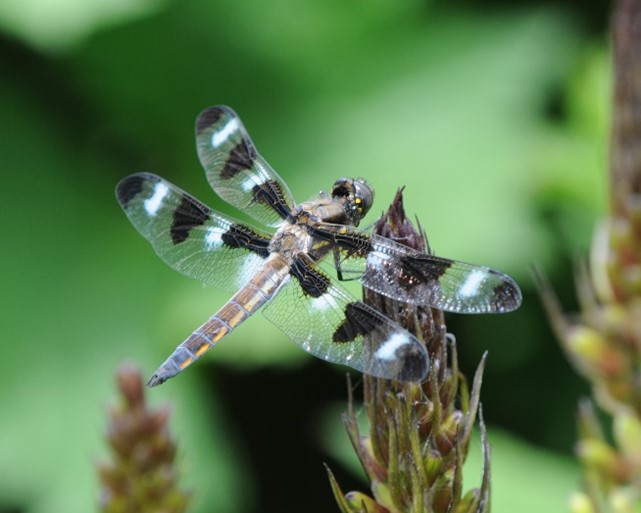By Roger Rittmaster
June 19, 2023
On a sunny day in June, I can walk out into my backyard to a wall of mosquitoes. But if I burrow through that wall, and head down to the Megunticook River, the mosquitoes soon disappear. That’s because I’ve entered dragonfly and damselfly territory, the land of nature’s natural mosquito killers. Mosquitoes are their favorite food.
Dragonflies and damselflies are members of the insect order Odonata and together are called “odonates” by taxonomically-minded naturalists. In Mid-Coast Maine they begin to emerge from their watery confines around the last week in May. They were right on time this year, but then a week of cool, wet weather put a dead stop to the process since they only emerge and fly on sunny days.
The life history of our odonates started last year when females laid eggs in or near water.

Twin-spotted Skimmer (dragonfly) ovipositing (placing eggs) directly in the water. Notice the concentric circles of waves emanating from where the tip of its abdomen touched the water. Sometimes a dragonfly will mistake the shiny paint on a vehicle for water and attempt to deposit eggs on it.
Odonate larvae are aggressive carnivores in their aqueous environment, gradually growing over the course of a year. They don’t look anything like the adults, but by the end of their aquatic existence, the fully-formed adult is present inside the larva’s exoskeleton (“skin”). In other words, they don’t undergo complete metamorphosis like a butterfly, where a pupae is formed , and the caterpillar transforms into an adult. Rather, they undergo an incomplete metamorphosis, skipping the pupal stage, with the adult emerging from the exoskeleton of the larva.


The process of emergence is relatively easy to see this time of year. Find a lake or pond with aquatic vegetation, and early on a warm, sunny morning, watch for the larvae crawling up the shoreline vegetation. The process is shown below for a Chalk-fronted Corporal dragonfly, clockwise starting in the upper left photo.




First, the aquatic larva crawls from the water onto a plant. The exoskeleton then splits open on the back (upper right photo), and the adult gradually emerges from the split. Once emerged (lower right), the adult must dry its wings, before it can open them and fly. This is when the larva is most vulnerable to predation, or, if the weather changes and becomes cold and rainy, the insect can die before it is able to find cover. The new adult has shiny wings and may take a day or more to develop its adult coloration. Most adult dragonflies and damselflies only live for a short time, a few weeks at most. Different species fly at different times during the late spring, summer and early fall.
Dragonflies and damselflies are easy to tell apart if you know what to look for:


Dragonflies are generally bigger with bulkier abdomens (tails). Even when small, the abdomen of dragonflies is bigger than damselflies, relative to their size. Dragonflies have eyes that meet, or almost meet, in the center, while damselflies have widely-separated eyes placed laterally, reminiscent of those of a hammerhead shark. Dragonflies land with their wings apart (except sometimes when they first emerge), while damselflies land with their wings together (except for spread-wing damselflies, genus Lestes). And, the wings of damselflies narrow to the base (nearest the body), whereas the diameter of dragonfly wings are similar at the base and tip.
One key feature that is common to both dragonflies and damselflies is how they mate. Prior to mating, the male transfers sperm from his genital opening near the end of his abdomen (9th abdominal segment – there are 10 in total) to a sperm storage organ in its penis near the beginning of the abdomen (2nd abdominal segment). Initially, the male grabs the female on the back of the head with his cerci (appendages at the tip of the abdomen), and the female then bends her abdomen to allow her genital opening to abut the male’s penis and permit transfer of sperm into her genital opening. This creates a “wheel” configuration, best seen in the photograph below on the right.
Mated dragonflies and damselflies


I hope this brief summary persuades you of the value and beauty of these distinctive insects. Here are a couple of my favorites:



